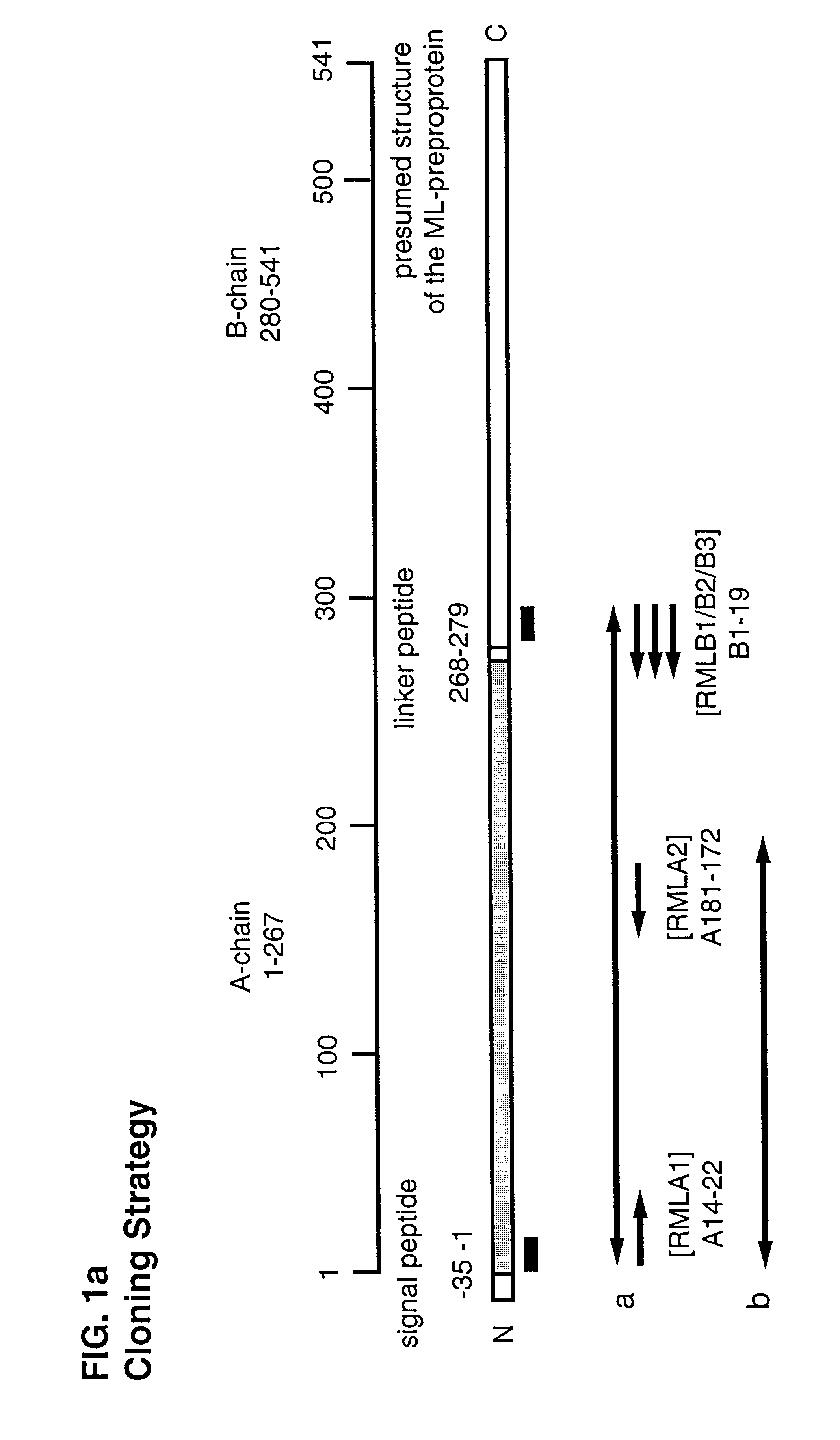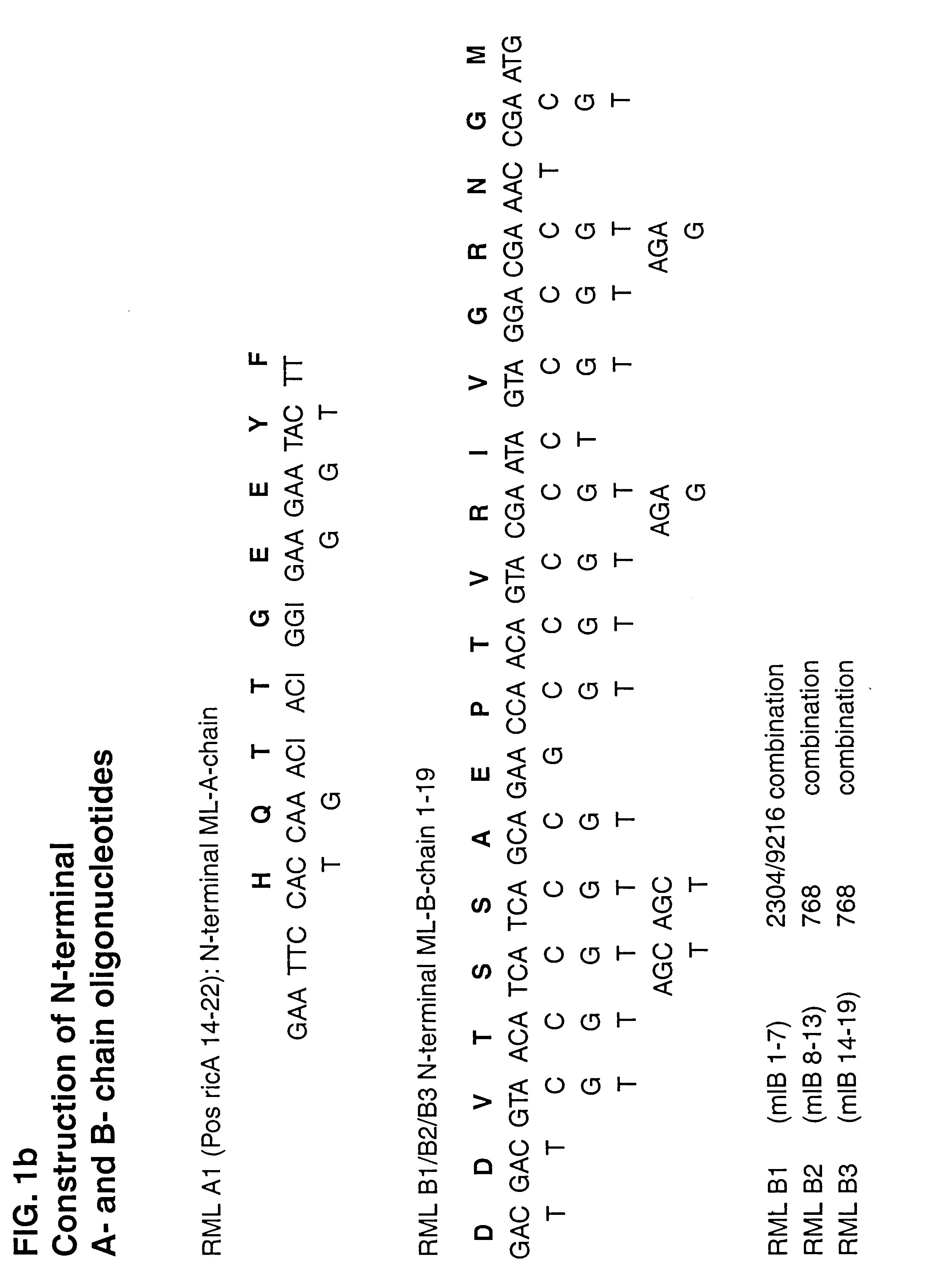Recombinant mistletoe lectin (rML)
a technology of mistletoe and lectin, which is applied in the direction of fusion polypeptide, dna/rna fragmentation, plant/algae/fungi/lichens ingredients, etc., can solve the problems of difficult analysis of structure/function relationships and inability to achieve the aims of the process
- Summary
- Abstract
- Description
- Claims
- Application Information
AI Technical Summary
Problems solved by technology
Method used
Image
Examples
example 1
Construction of the Primary Amplification Oligonucleotides
Mistletoe lectin (ML) belongs to the class of ribosome-inactivating proteins [Stirpe et al., 1992] which represents a protein family widely common to plants of various taxonomic origin. ML was attributed to the group of the type II ribosome-inactivating proteins due to the activities of its subunits [Endo et al., 1988a].
The obvious approach of screening Viscum album cDNA and genomic libraries, however, is completely inappropriate for finding the ML gene sequence. Despite using various DNA probes no ML specific clones could be identified in gene libraries from Viscum album poly-A+ RNA. Based on the assumption that the ML gene sequence does not contain introns a PCR strategy was followed. Since the N-terminal amino acid sequences were known both for MLA and MLB chain [Dietrich et al., 1992; Gabius et al., 1992], it appeared possible to amplify the MLA coding region using degenerate amplification oligonucleotides which had been ...
example 2
Preparation of ML-gene Specific DNA Fragments
High molecular, genomic DNA was isolated according to the method of Baur et al. [1993] from fresh Viscum album leaves (host tree Populus wilsonii). For the preparation of ML-gene specific DNA fragments by PCR 100 ng genomic DNA were used for each amplification reaction. Amplification was carried out in a total volume of 50 .mu.l, containing PCR buffer (10 mM Tris-HCl, 1.5 mM MgCl.sub.2, 50 mM KCl, 0.25 mM DNTP, pH 8.3), 78 pmol primer RMLA1 (SEQ ID NO:1) and 50 pmol (reaction 2) or 100 pmol (reaction 1) RMLA2 (SEQ ID NO:2). PCR was carried out with Taq DNA polymerase (1.5 U / reaction) of Boehringer Mannheim in a Biometra thermocycler. The PCR parameters were: 1 min denaturation at 90.degree. C., 1 min annealing at 50.degree. C., 1 min elongation at 72.degree. C. for a total of 30 cycles. The amplification products were analyzed by 5% polyacrylamide gel electrophoresis and staining with ethidium bromide (FIG. 2). The specific amplification ...
example 3
Cloning Strategy
The derivatization of the amplification oligonucleotides used for primary PCR is shown in Example 1 (FIG. 1a), the preparation of the primary gene fragment of the Viscum album ML gene, referred to in the following as "a", is shown in Example 2 (FIG. 2). Starting from the sequence of the cloned gene fragment "a" and from the assumption that the ML gene does not have any introns it was possible to derive sequence-specific 5' oligonucleotides which allowed an amplification of the fragments "b", "c", "d" and "e". While the 3' oligonucleotide for "c" was also derived from the DNA sequence of "a", the degenerate 3' primer for the amplification of the gene fragments "b", "d", "e" and "g" had to be constructed by analysis of homologous regions of type I ("b") and type II ("d", "e", "g") RIP proteins. The sequence comparisons within the protein families were again used to infer the presence of individual residues, paying particular attention to those residues having a low deg...
PUM
| Property | Measurement | Unit |
|---|---|---|
| Biological properties | aaaaa | aaaaa |
| Cytotoxicity | aaaaa | aaaaa |
Abstract
Description
Claims
Application Information
 Login to View More
Login to View More - R&D
- Intellectual Property
- Life Sciences
- Materials
- Tech Scout
- Unparalleled Data Quality
- Higher Quality Content
- 60% Fewer Hallucinations
Browse by: Latest US Patents, China's latest patents, Technical Efficacy Thesaurus, Application Domain, Technology Topic, Popular Technical Reports.
© 2025 PatSnap. All rights reserved.Legal|Privacy policy|Modern Slavery Act Transparency Statement|Sitemap|About US| Contact US: help@patsnap.com



